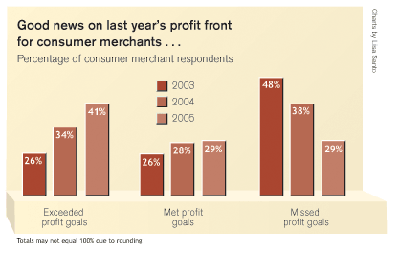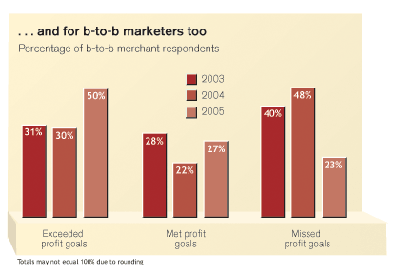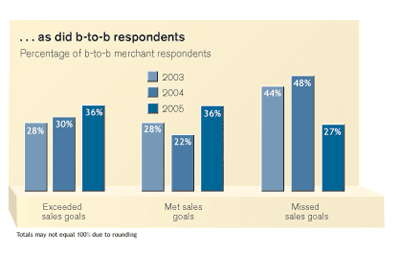It’s enough to make you break out into a chorus of “Happy Days Are Here Again”: An impressive 74% of respondents to Multichannel Merchant’s 2005 Benchmark Survey on Critical Issues and Trends reported that their companies had met or exceeded profit goals last year, up from 63% of the 2004 respondents and just 51% of respondents two years ago. And 70% had met or exceeded their revenue goals, compared with 64% of the 2004 participants and 58% of the 2003 respondents.


And the good-news trend continued through the first half of this year. Seventy-six percent of the multichannel merchants surveyed said that they’d met or exceeded their profit expectations for the first six months of 2005, and 69% had met or exceeded their sales goals for the same period.


Respondents felt optimistic about the year ahead as well. Although the survey was conducted from Sept. 14 through Sept. 27, when executives might understandably have been concerned about the effect of rising fuel costs in the wake of hurricanes Katrina and Rita, 45% of respondents nonetheless predicted that during the next 12-24 months their businesses would grow at a faster rate than they had during the past two years. Another 27% anticipated the same rate of growth during the next two years as they’d enjoyed during the past two.
Despite the rosy financial figures, respondents to the survey still felt the need to trim costs without cutting offerings or services. Eighty-seven percent of participants rated it one of their top three management issues, making it by far the most-cited issue overall. The number-one merchandising and operations concern was also cost related: Forty-nine percent of respondents said that rising package delivery costs were one of their three most pressing merchandising and operations concerns. As for marketing concerns, managing multiple marketing channels was cited most frequently, by 36% of respondents.
Business-to-business respondents were far more worried about rising catalog distribution costs than were their counterparts at consumer companies. Nearly one-third (32%) of the b-to-b participants cited it as one of their top three marketing issues, compared with 15% of the business-to-consumer respondents. And more b-to-bers (27%) than b-to-c respondents (18%) cited the need to acquire customers more profitably as a top concern. On the flip side, while 38% of the consumer respondents cited managing multiple marketing channels as a top concern, only 27% of the b-to-b participants felt the same.
B-to-b executives were much more worried about the need to integrate operations for multiple channels: 57% named it as one of their top three merchandising and operational concerns, compared with a scant 12% of b-to-c respondents. But while 26% of the executives at consumer companies cited as a major issue the need to upgrade customer service operations to remain competitive, fewer than 10% of the b-to-b respondents did.
B-to-b and b-to-c respondents also differed regarding their use of e-mail as a marketing tool. Nearly three-quarters (74%) of the executives at consumer companies said they had an e-mail marketing campaign in place, and every single one of those that didn’t said they were considering implementing one. But only half of the b-to-b companies had an e-mail marketing campaign; of the remainder, 27% weren’t even considering adding one. Among all respondents that used e-mail marketing, incidentally, 53% said their response rates had increased during the past year; only 12% saw a decline.
For both business and consumer merchants with print catalogs, proprietary Websites were the favored medium for promoting them (used by 84% of b-to-c respondents and 78% of b-to-b respondents). But when asked which media they planned to use to promote their print catalogs in the next 12 months, more b-to-c respondents expected to use e-mail (84%) than their Websites (77%). More consumer merchants will likely use solo mailers and other sorts of noncatalog direct mail too: Whereas 29% said they currently used them to promote their catalog, 39% planned to use them next year. Likewise, only 6% of b-to-c respondents said they promoted their catalogs in trade publications, but 19% intended to do so in the coming year.
B-to-b respondents anticipated making far fewer changes to their catalog promotion strategy in 2006. The one appreciable difference: 56% of those with catalogs expected to promote them via e-mail next year, whereas only 39% had done so this year.
Top marketing concerns
Respondents with sales of less than $10 million
The b-to-b respondents also expected to use e-mail more to promote their Websites: 48% of those with Websites used e-mail this year, but 62% planned to do so next year. Again, though, the business merchants as a whole didn’t plan to dramatically increase or decrease their usage of other media to tout their sites.
Respondents with sales of at least $10 million
Not so the respondents at b-to-c companies; they planned to rev up their traffic-driving efforts big-time. This year 88% used e-mail to promote their Website; 97% expected to do so next year. Thirty-two percent used solo mailers and other types of noncatalog direct mail this year, but 41% expected to do so next year. This year 29% used online services such as America Online; 38% planned to next year. Likewise, 29% used co-op Websites or online malls this year, but 38% expected to use them next year. And while just 12% of the b-to-c respondents with Websites used trade publications to drive online traffic this year, twice as many expected to do so next year.
Most popular media used to promote print catalogs
B-to-c respondents:
- Finding prospects 50%
- Increasing competition from manufacturers and retailers entering catalog/Web marketing 40%
- Managing multiple marketing channels 33%
- Rising catalog distribution costs 33%
B-to-b respondents:
- Managing multiple marketing channels 42%
- Retaining customers 32%
- Increasing competition in my specific product market 29%
- Matching back the source of buyers to the correct medium and promotion 29%
Most popular media used to promote Websites
B-to-c respondents:
- Own Website 84%
- E-mail 77%
- Space ads 29%
- Solo mailers/other direct mail 29%
B-to-b respondents:
- Own Website 78%
- Solo mailers/other direct mail 61%
- Trade publications 44%
Top merchandising and operations concerns
Respondents with sales of less than $10 million
- E-mail 88%
- Print catalog 68%
- Banner ads on other Websites 35%
Respondents with sales of at least $10 million
- Print catalog 62%
- E-mail 48%
- Solo mailers/other direct mail 48%
- Trade publications 48%
Top management concerns
Respondents with sales of less than $10 million
- Rising costs of package delivery 60%
- Rising customer service expectations 40%
- Inventory forecasting 37%
Respondents with sales of at least $10 million
- Inventory forecasting 56%
- Rising costs of package delivery 49%
- Rising customer service expectations 33%
Methodology
- Need to reduce costs without reducing offerings/services 83%
- Difficulty in securing additional/continuing financial support 43%
- Difficulty in finding experienced staff 40%
- Need to reduce costs without reducing offerings/services 90%
- Difficulty in finding experienced staff 51%
- Difficulty in retaining staff 32%
On Sept. 14, Primedia Business e-mailed invitations to participate in an online survey to 6,795 subscribers of Multichannel Merchant selected on an nth-name basis. The invitation contained a link routing respondents directly to the Website where the survey questionnaire was located. Respondents were offered a chance to be entered into a drawing for one of four $50 Amazon.com gift certificates. A follow-up e-mail was sent on Sept. 20. Of 5,905 deliverable surveys, 101 surveys were completed, for an effective response rate of 1.7%.
